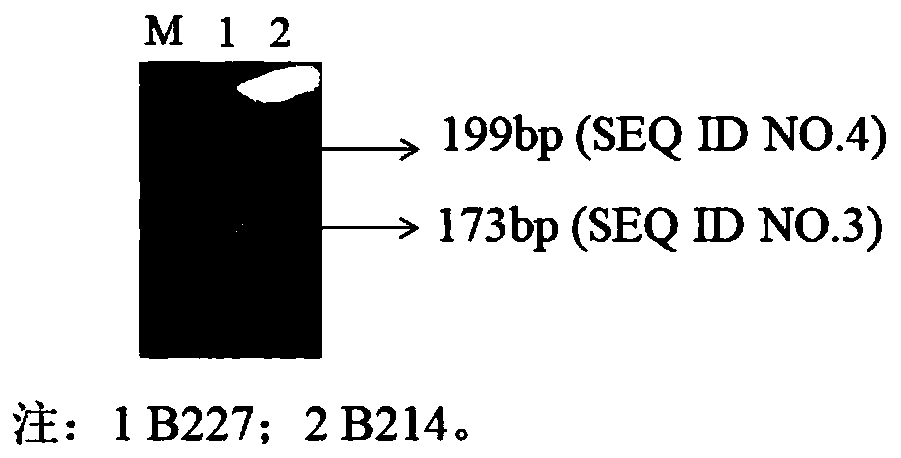A kind of SNP molecular marker of wax gourd seed type gene and its application
A technology of molecular markers and wax gourd seeds, which is applied in the direction of recombinant DNA technology, microbial measurement/testing, DNA/RNA fragments, etc., to achieve the effects of strong specificity, easy operation, and short identification cycle
- Summary
- Abstract
- Description
- Claims
- Application Information
AI Technical Summary
Problems solved by technology
Method used
Image
Examples
Embodiment 1
[0044] The development and verification process of the SNP molecular marker of the wax gourd seed type gene provided in this example and the primer pair (dCAPS primer pair) for amplifying the SNP molecular marker is as follows:
[0045] Materials: Sources of parents: B227: Unilateral seed parent, B214: Bilateral seed parent.
[0046] A six-generation segregation population was constructed with unilateral-seeded wax gourd B227 and bilateral-seeded wax gourd B214 as parents, and the genetic law of wax gourd seed type was studied. The results showed that bilateral and unilateral are the quality traits controlled by a pair of nuclear genes, and bilateral to unilateral is dominant. . Subsequently, using the F 2The high-density genetic map of wax gourd was constructed by the population, and the seed type gene was located on chromosome 4, and the genetic distances between it and the markers on both sides were 0.4cM and 0.8cM, respectively.
[0047] According to the genome resequenc...
Embodiment 2
[0057] The identification method of the wax gourd seed type that the present embodiment provides, comprises the following steps:
[0058] (1) Extraction of wax gourd DNA
[0059] The experimental materials are fresh leaves of B227 and B214, and the steps of extracting genomic DNA are as follows:
[0060] ①Put a small amount of fresh leaves into a 2mL centrifuge tube, add liquid nitrogen and grind with a grinding pestle, quickly add 800 μL 2% CTAB extract when the liquid nitrogen is quickly evaporated, mix well and place in a 65°C water bath for 45 minutes (shaking every 10 minutes) uniform once);
[0061] ② After standing at room temperature, add 800 μL of chloroform:isoamyl alcohol (24:1), mix gently, let stand for 2 minutes, centrifuge at 12000 rpm for 15 minutes, transfer the supernatant (about 510 μL) to a new 1.5 mL centrifuge tube ;
[0062] ③ Add 1 / 3 volume of NaAc (3mol / L) to the supernatant, add 1.5 times the volume of supernatant to absolute ethanol (pre-cooled at...
Embodiment 3
[0081] The method of Example 2 was used to verify 96 individual plants of the F4:5 family population of B227 and B214 (the first generation of F2 population selfing is F2:3 family, and the second generation of selfing is F3:4, and then F4:5) . Each individual plant was numbered separately, and the DNA of the individual plant was extracted for detection (see image 3 ); if two bands are heterozygous, the band type is bilateral, and for one band, the large segment is bilateral, and the small segment is unilateral.
[0082] According to the results of marker detection, there were 60 individual plants with 199bp band type (bilateral homozygosity), 8 individual plants with 173bp band type (unilateral homozygous), 20 heterozygous band type (bilateral heterozygous), and the remaining 8 unamplified bands.
[0083] The field trait identification results were consistent with the marker detection results, and the accuracy rate reached 100%.
PUM
 Login to View More
Login to View More Abstract
Description
Claims
Application Information
 Login to View More
Login to View More - R&D
- Intellectual Property
- Life Sciences
- Materials
- Tech Scout
- Unparalleled Data Quality
- Higher Quality Content
- 60% Fewer Hallucinations
Browse by: Latest US Patents, China's latest patents, Technical Efficacy Thesaurus, Application Domain, Technology Topic, Popular Technical Reports.
© 2025 PatSnap. All rights reserved.Legal|Privacy policy|Modern Slavery Act Transparency Statement|Sitemap|About US| Contact US: help@patsnap.com



